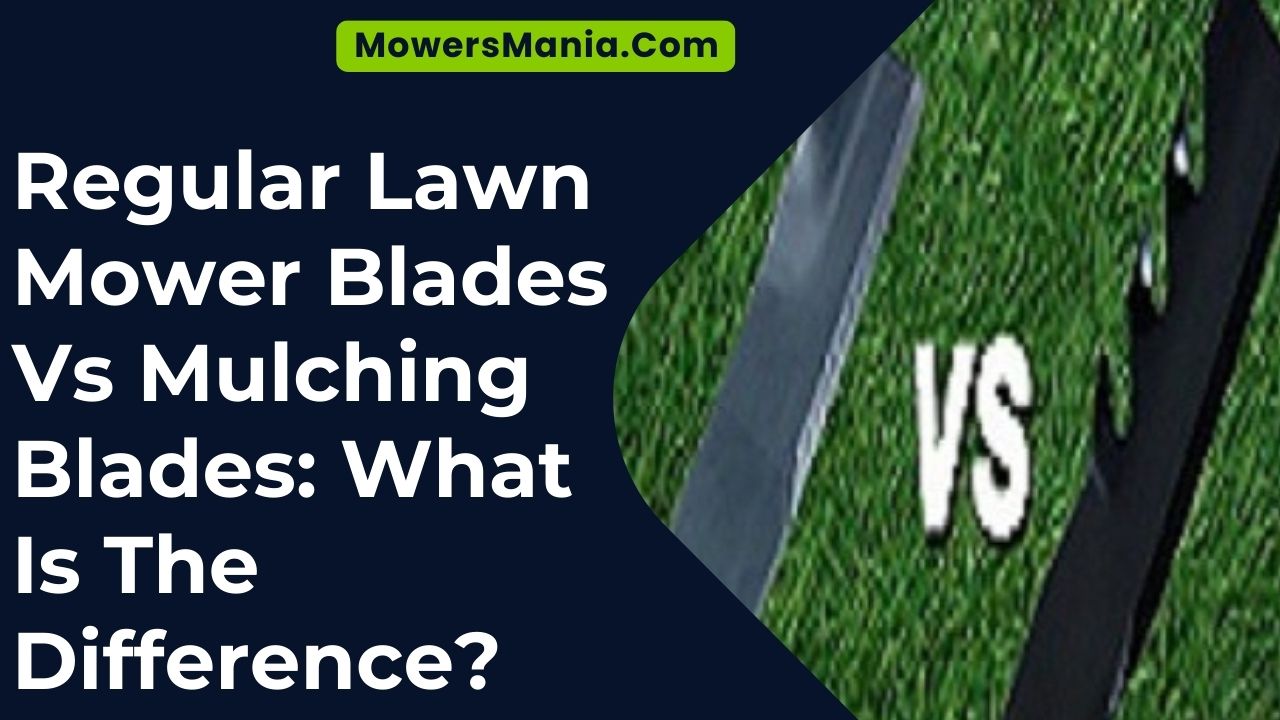If you’re wondering about the differences between regular lawn mower blades and mulching blades, you’ve come to the right place.
We’ll break down the key distinctions in blade design, cutting capabilities, grass clipping management, and overall impact on your lawn’s health.
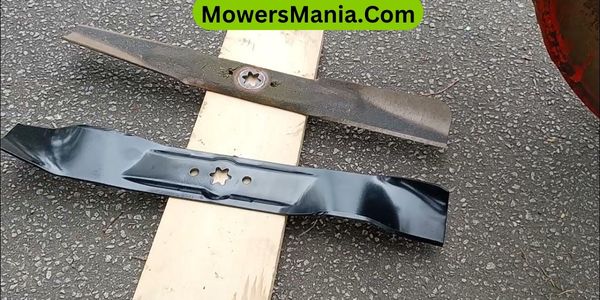
Whether you’re mowing in wet or dry conditions, understanding these differences will help you choose the best option for your lawn maintenance needs.
Blade Design and Construction
When comparing regular lawn mower blades to mulching blades, you’ll notice a distinct difference in the design and construction of the two types.
Regular mower blades typically have a straight shape with a sharp edge, designed to cut grass cleanly.
On the other hand, mulching blades have a more curved design with added cutting surfaces along the edges. These added cutting surfaces are essential for the mulching process, as they help to chop the grass into finer pieces.
Moreover, mulching blades feature more lift along the curved edges, which creates an upward airflow. This airflow helps to keep the grass aloft, allowing the blades to make multiple cuts and further mulch the grass into smaller pieces.
Additionally, the design of mulching blades often incorporates extra cutting edges and a unique shape to enhance the mulching capability.
This design and construction enable mulching blades to finely chop grass and return the clippings to the lawn, providing essential nutrients for a healthier, greener lawn.
Cutting and Discharge Capabilities
To understand the cutting and discharge capabilities of regular lawn mower blades versus mulching blades, consider how the design and construction of each blade type directly impact its performance.
Regular lawn mower blades are designed to provide a powerful, high-speed cut, making them ideal for quickly mowing large areas of grass. These blades typically have a straight shape with a sharp edge, which efficiently slices through the grass.
However, the cut grass is usually discharged out of the mower deck in larger clippings, which can lead to uneven distribution and the need for additional cleanup.
On the other hand, mulching blades are specifically engineered to finely chop the grass into smaller pieces and then force the clippings back into the lawn for natural decomposition. This process helps to nourish the soil and promote a healthier lawn.
The unique curved design and added cutting surfaces of mulching blades enable them to repeatedly cut the grass and further pulverize the clippings before dispersing them back onto the lawn.
This results in a cleaner-looking yard with no visible clumps of grass, while also providing beneficial nutrients to the soil.
Grass Clipping Management
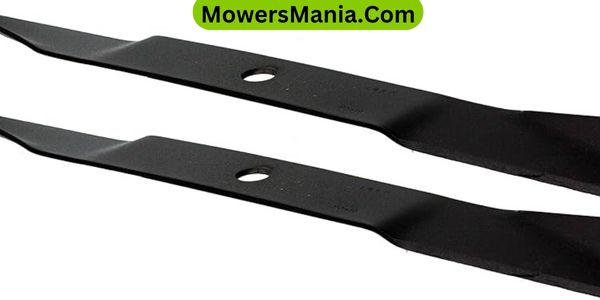
Manage grass clippings effectively by considering the cutting and discharge capabilities of regular lawn mower blades versus mulching blades.
When it comes to grass clipping management, the type of mower blade you use can make a significant difference.
Regular lawn mower blades and mulching blades have distinct characteristics that affect how grass clippings are handled and dispersed on your lawn.
Here are some key factors to consider for grass clipping management:
- Discharge Method: Regular blades typically discharge clippings through a side chute or the rear of the mower, while mulching blades are designed to finely chop clippings and disperse them back onto the lawn.
- Clipping Size: Regular blades cut grass into larger pieces that are more visible on the lawn, whereas mulching blades create finer clippings that decompose quickly and are less noticeable.
- Nutrient Recycling: Mulching blades promote nutrient recycling by returning finely chopped clippings to the soil, providing valuable nutrients to the grass.
- Thatch Reduction: Mulching blades help reduce thatch buildup by breaking down clippings into smaller particles that decompose more easily.
- Overall Lawn Health: Proper grass clipping management with mulching blades can contribute to healthier, greener lawns by providing essential nutrients and promoting soil health.
Impact on Lawn Health
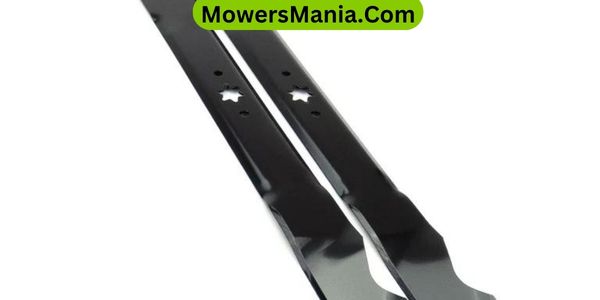
Considering the impact on lawn health, you can observe the difference in nutrient recycling and thatch reduction between regular lawn mower blades and mulching blades.
Regular lawn mower blades cut the grass and leave clippings on the lawn’s surface, which can take longer to decompose and contribute to thatch buildup.
On the other hand, mulching blades finely chop the grass clippings and return them to the soil, promoting nutrient recycling and reducing thatch. This difference can significantly impact the overall health and appearance of your lawn.
To better understand the impact on lawn health, let’s compare the effects of regular blades and mulching blades:
| Impact | Regular Blades | Mulching Blades |
|---|---|---|
| Nutrient Recycling | Clippings left on the surface, leading to slower decomposition and potential nutrient loss. | Finely chopped clippings returned to the soil, promoting nutrient recycling and enhancing soil health. |
| Thatch Reduction | Clippings contribute to thatch buildup, requiring dethatching. | Reduced thatch buildup due to finely chopped clippings, leading to less frequent dethatching needs. |
Performance in Different Conditions
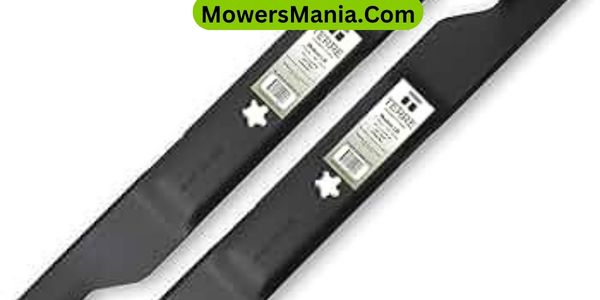
When mowing under various conditions, it’s important to consider how mulching blades perform compared to regular blades.
Mulching blades are designed to finely chop grass clippings, which can be beneficial in different mowing conditions.
Here’s how mulching blades compare to regular blades in various conditions:
- Wet Grass: Mulching blades are more effective at cutting and mulching wet grass compared to regular blades, which may clump and leave behind uneven clippings.
- Tall Grass: Mulching blades can handle tall grass better by evenly chopping the clippings into smaller pieces, promoting better decomposition and a healthier lawn.
- Uneven Terrain: Mulching blades work well on uneven terrain, as they provide a more consistent cut and distribute the clippings more evenly, reducing the risk of thatch buildup.
- Damp Conditions: In damp conditions, mulching blades are less likely to leave behind clumps of clippings, resulting in a neater appearance and promoting a healthier lawn.
- Dry Conditions: Mulching blades can still effectively mulch dry grass, but regular blades may leave behind larger clippings that take longer to decompose.
Frequently Asked Questions [FAQs]
Can Regular Lawn Mower Blades Be Used Interchangeably With Mulching Blades?
Regular lawn mower blades and mulching blades are not interchangeable. Regular blades are designed for standard grass cutting, while mulching blades are designed to finely chop grass and return it to the lawn as mulch.
Do Mulching Blades Require More Maintenance Than Regular Lawn Mower Blades?
Mulching blades don’t require more maintenance than regular lawn mower blades. They’re designed to cut grass into smaller pieces, promoting healthier grass growth. Regular blades simply cut and discharge clippings, while mulching blades actively mulch.
Are Mulching Blades More Expensive Than Regular Lawn Mower Blades?
Mulching blades are typically a bit more expensive than regular lawn mower blades. However, the added cost is worth it for the improved grass cutting and mulching capabilities that mulching blades provide.
Can Mulching Blades Be Used on All Types of Grass?
Yes, mulching blades can be used on all types of grass. They are designed to finely chop grass clippings into small pieces, which can then decompose and return nutrients to the soil, benefiting your lawn.
Will Using Mulching Blades Affect the Overall Appearance of the Lawn Compared to Regular Lawn Mower Blades?
Using mulching blades will significantly improve the overall appearance of your lawn compared to regular mower blades. They finely chop grass clippings, providing vital nutrients and promoting a healthier, more manicured look.
Conclusion
In conclusion, the difference between regular lawn mower blades and mulching blades lies in their design, cutting capabilities, and impact on lawn health.
Regular blades are designed for standard cutting and discharge. They are typically straight and have a single cutting edge. When the grass is cut, the clippings are discharged out of the mower deck and onto the lawn. This can leave behind visible clippings and may require additional cleanup.
On the other hand, mulching blades are designed to finely chop grass clippings and return them to the lawn. They have a curved shape with multiple cutting edges. As the grass is cut, the clippings are repeatedly chopped into smaller pieces. These smaller clippings then fall back onto the lawn and decompose quickly. This process is known as mulching, and it helps to nourish the lawn by returning valuable nutrients to the soil.
Mulching blades can contribute to better lawn health. The finely chopped clippings act as a natural fertilizer, providing nutrients like nitrogen, phosphorus, and potassium to the soil. This can promote healthier growth and reduce the need for additional fertilizers.
Mulching blades are also more effective in certain conditions. For example, in dry weather, they can help to retain moisture in the soil by creating a layer of mulch. This reduces evaporation and helps to keep the lawn hydrated. Additionally, mulching blades are beneficial when mowing tall or thick grass, as they can handle the extra volume of clippings more efficiently.
Overall, mulching blades are a preferred choice for many homeowners. They not only provide convenience by eliminating the need for clippings cleanup but also contribute to better lawn health. However, it’s important to note that regular blades may still be suitable for certain situations, such as when a clean-cut appearance is desired or when mulching may not be practical.

